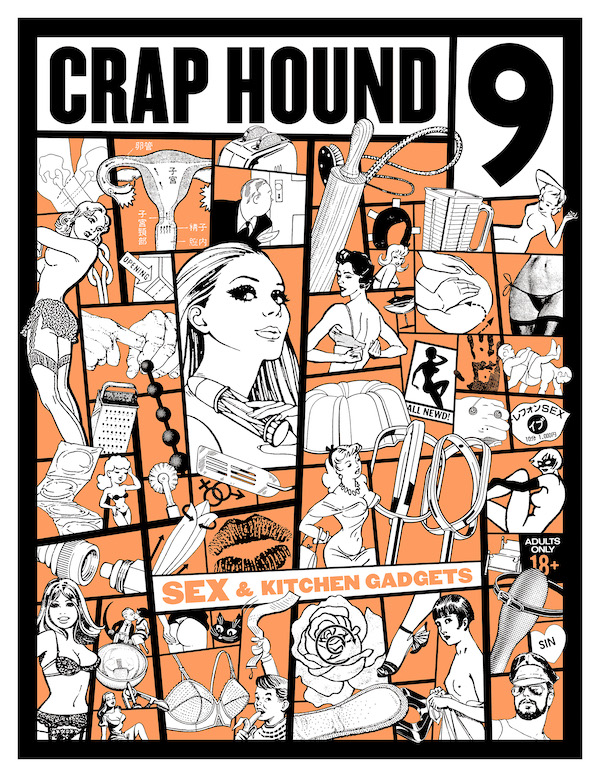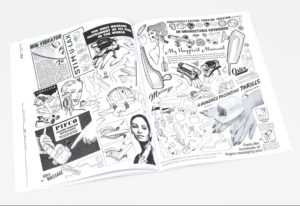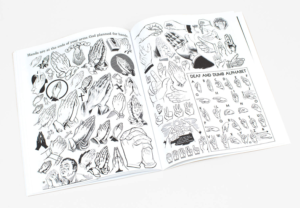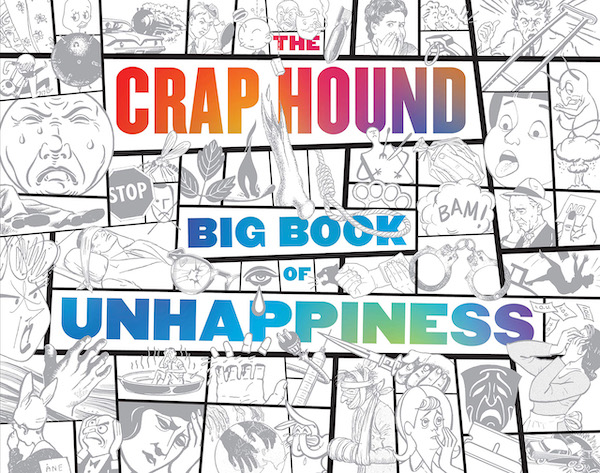Sean Tejaratchi is a taxonomic guerrilla and semiotic hoarder. His social media phenomenon (and book) Liartown generated a tsunami of WTF memes, that have been described as “layered, multivalent detournees of the entire gamut of visual culture from the last century and a half,” and have rightly garnered him a modicum of hybrid literary/graphic design/comedic/web culture celebrity. But Tejaratchi’s cult began way back in the early ’90s, with the unleashing of his eye-boggling all-clip-art zine Crap Hound (CH).
Clip art in this case consists of not only the licensed generic line drawings of happy consumers, etc., but of unique magazine spot illustrations, as well as images from cartoon advertisements, public service pamphlets, food packaging, religious tracts, anthropomorphic business logos, and so on—mostly dating from the Golden Era of print media from the ’30s to the ’60s. Each issue had one or more themes; the first was “Death, Telephones & Scissors” and subsequent volumes centered on “Clowns, Devils, & Bait,” “Superstition,” and so on.

Crap Hound #9 cover.
These massive periodicals offered thousands of related images arranged in intricate mosaics that orchestrated the already visually interesting and entertaining pictorial units into playful and dramatic page designs, mutating the staid inventories of a Dover Pictorial Archive, with a dose of punk plunderphonics, into something rich and strange.
Nothing, however, could have prepared us for The Crap Hound Big Book of Unhappiness (CHBBoU)—Tejaratchi’s literal magnum opus, a doorstop of a book that extends the CH formula across 270ish pages and into another dimension altogether. Originally conceived in 1999, as an antidote to mainstream design culture’s embracing of the chirpier end of the vintage clip-art spectrum, the project was repeatedly back-burnered, though Tejaratchi’s stash of graphically reified misery continued to grow and grow.

Crap Hound #9 page spread.
Published by Feral House (who also published Liartown, and with whom Tejaratchi has worked as a designer) just in time for the holidays (the perfect gift for bitter old hipsters and angst-drenched teens alike!) the CHBBoU compiles thousands upon thousands of separate images depicting an encyclopedic array of unpleasantness —men, women, children and even pets in states of confusion, pain, fear, stress, anger, embarrassment, sorrow, depression and frustration. Tejaratchi accurately forecast back in ’99, “Headaches, upset stomachs, storms, earthquakes, fires, floods, vehicular collisions, weight issues, drugs, suicide, murder, execution and punishment, atomic bombs, unemployment, riots, injuries, falls, fistfights, tantrums, and the silent, nocturnal shame of bedwetting… From the tearful sting of a scraped knee to the ominous shadow of impending planetary doom, you can expect a rich tapestry of trouble.”

Crap Hound #5 page spread.
Indeed. Tejaratchi’s cup of rue is so full, in fact, that it hath runneth over into a standalone zine Crap Hound #10: More Unhappiness—available, as are reprints of earlier issues and the legendary “Social Justice Kittens calendar” —at buyolympia.com. And this isn’t some condensed version or sampler, but a wholly autonomous volume addressing the same themes, but toggling back to the traditional CH portrait-oriented layout.

Crap Hound #5 page spread.
This last zine is significant in that it reiterates the surprising narrative quality the Big Book’s horizontal format brings to the fore. The CH zine always struck me as some sort of avant-garde comix, with its intricate, clattering rows of nearly identical signs, stuttering populist archetypes burnished into cliches, fragments of stories reiterated from dozens, hundreds of slightly different POVs.
The cloud of connotative difference between an early 20th-century angry white man rendered in old testament engraving stylee and a 1960s angry white man executed in the Modernism-informed New Yorker panel mode could probably fill a dissertation. But it doesn’t have to, because it’s right there in front of you, in sign language (times gazillion).

Crap Hound #9 page spread.
The horizontal format (and long duration) does make the CHBBoU seem like a codex, or hieroglyphic scroll—a pictorial key to unlocking the mysteries of a lost civilization. But the implicit universality of its theme—the suffering of humanity—tempers this seeming hermeticism—as does the sheer symbolic legibility of the content.
Tejaratchi’s compositional virtuosity adds another entire layer of narrative, but it’s the narrative of the eye’s journey around a page—up, down, back and forth, in and out, and through to the next. The currents and tides of various themes and variations—foul weather modulating into parasitical infestations, for example—are rhythmic and intuitive. In spite of the apparent arbitrary nature of its organizational principle, the CHBBoU comes off less like a hip graphic design cheat book than the “War and Peace” of semiotically appropriated collage graphic narrative. That’s gotta mean something!

Crap Hound #5 page spread.


